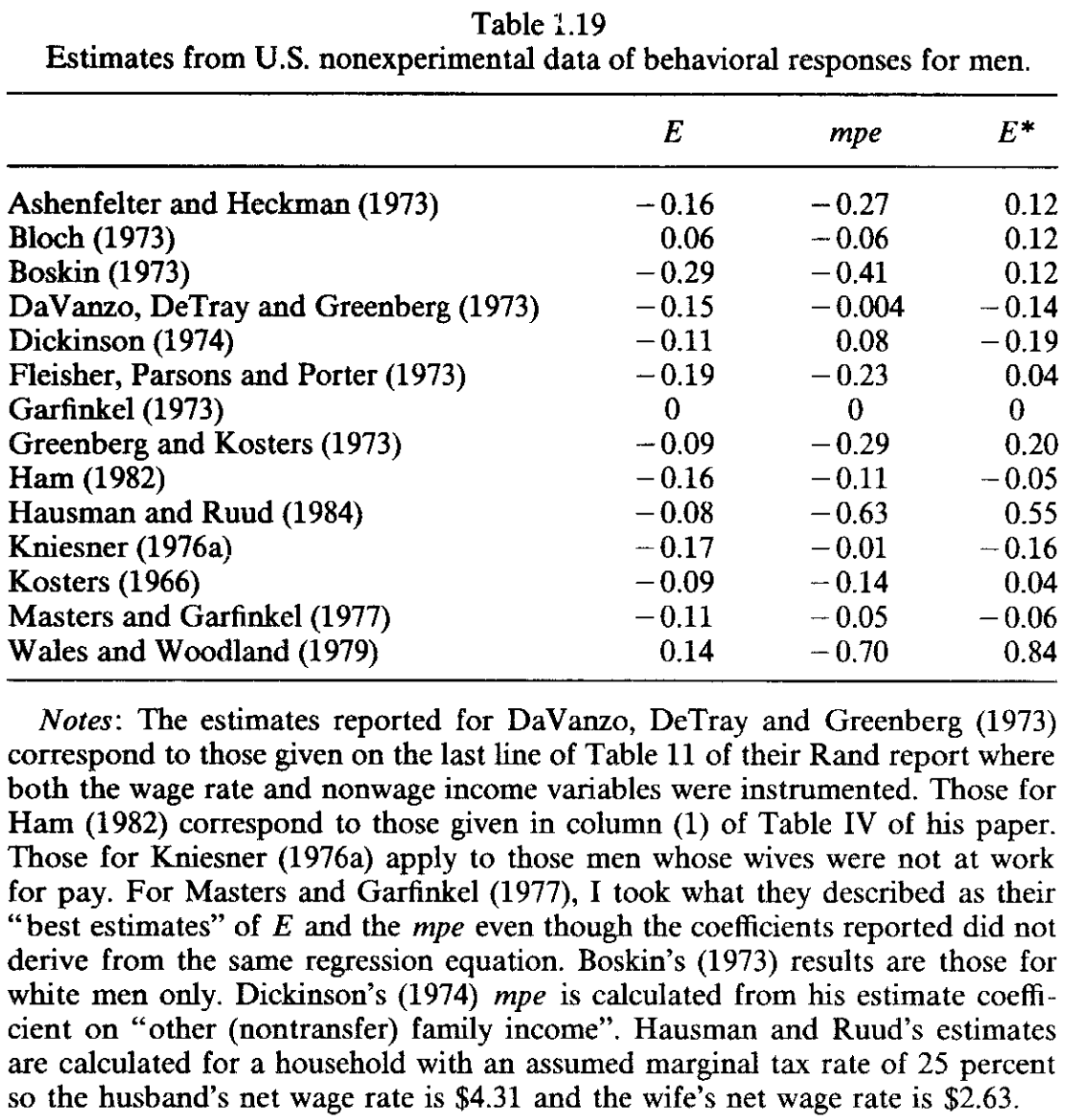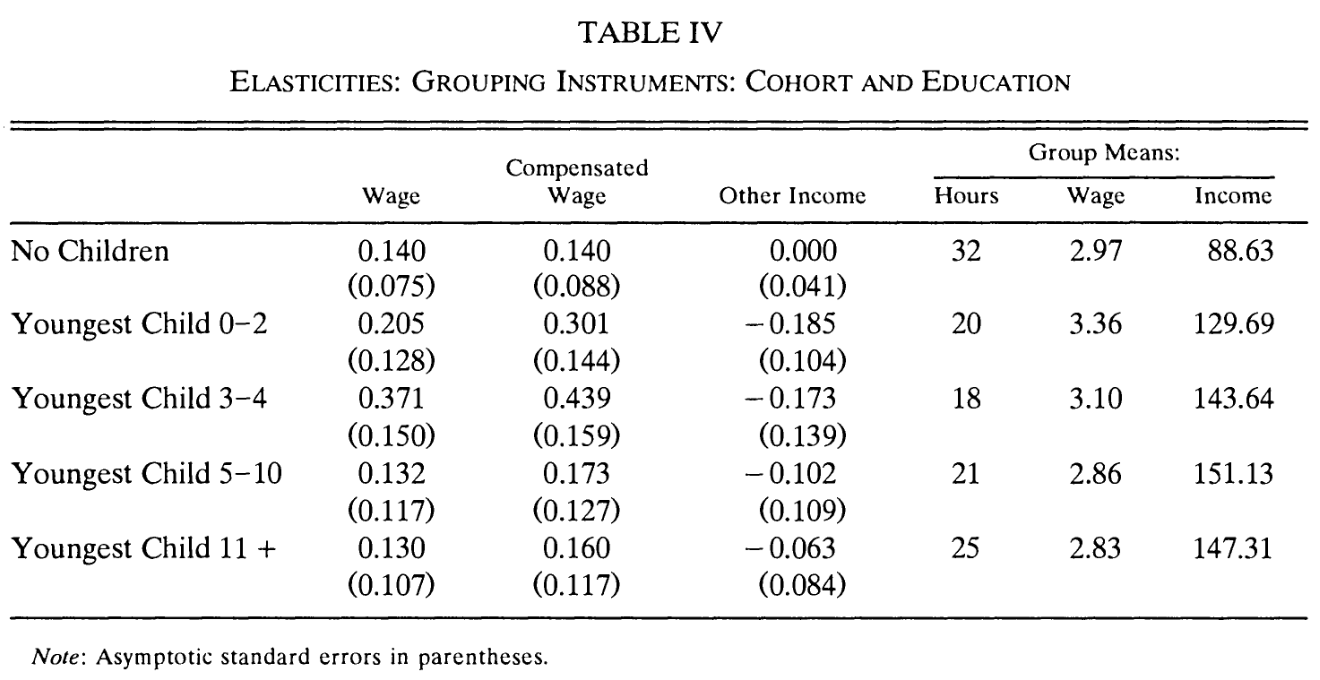2. Labour Supply
KAT.TAL.322 Advanced Course in Labour Economics
Labour supply
How people choose whether and how much they work?
Static model
Static labour supply
Model
- Utility from consumption of goods (
- Total time endowment
- Agent chooses
- Budget constraint is
Static labour supply
Solution
First-order conditions of the Lagrangian are
Solution pair
Static labour supply
Comparative statics
How does optimal labour supply change with
Marshallian (uncompensated) wage elasticity:
Hicksian (compensated) wage elasticity:
Decomposition into substitution and income effects:
Static labour supply
Comparative statics

Static labour supply
Labour supply curve

Household model
Intrahousehold labour supply
Unitary model
Household represented by single utility function
Budget constraint
Simple extension of static model
Not consistent with observed data
In the non-earned part, only total income
The solution doesn’t care about the distribution of these within household.
Empirical works shows that it does matter. For example, paying children support to husband account or wife account.
Intrahousehold labour supply
Collective model
Individual utility functions
Budget constraint
Partner utility constraint (Pareto efficiency)
In this case, individual program can be represented by
where
For more, see (Cahuc 2004, chap. 1) and Chiappori (1992)
Intertemporal model
Intertemporal labour supply
Model
General utility function
Separable utility function
Budget constraint
- savings rate
- total time normalized to one:
- assets
- non-labour income
Intertemporal labour supply
Solution
First-order conditions:
Iterating over all periods:
MRS = w is maintained at every period BECAUSE we assumed intertemporal separability
The optimal choice at every period depends on
The term
Initial value
Intertemporal labour supply
Wage elasticities of labour supply
Frisch elasticity
Marshallian elasticity
Hicksian elasticity
It is possible to show that
For derivations, see (Cahuc 2004, chap. 1 appendix 7.4)
Frisch elasticity: intertemporal substitution
Draw wage profile
Intertemporal labour supply
Example
Period utility
FOC:
- Evolutionary changes along anticipated wage profile
- Transitory changes
- Permanent changes
- Lottery win
Estimations
Empirical specifications
Basic regression equation
Interpretation of
Empirical specifications
Marshallian wage elasticity:
Income effect:
Hicksian wage elasticity:
Empirical specifications
Frisch elasticity
Recall that
Substitute
Frisch wage elasticity:
Empirical specifications
Practical issues
Wages and hours worked are endogeneous
Hours (
Measurement errors
Measures of
Individual vs aggregate labour supply
Estimates
Observational data

Large variation between different estimates
Some even report negative Hicksian elasticities!
Most likely to do with endogeneity in the data => next experimental
Estimates
Experimental data: drop in tax rates in the UK 1978-92

Now, Hicksian elasticities are of expected sign!
Are these values large? Some suggest participation is important, but overlooked in these studies!
Estimates
Intensive vs extensive margin

Also some research on work effort for given hours of work (Dickinson 1999)
Micro vs macro
Indivisible labour supply (Chetty et al. 2012)
Optimization frictions (Chetty 2012)
For example, hard to adjust hours continuously (contracts typically 8 hours); may be forced to search for another job.
Estimates
Measurement errors
Classical measurement error in
“Denominator bias”
among all papers: 0.31
among papers with direct measure of
Estimates
Measurement of consumption
PSID (US) dataset only includes food consumption data
| Consumption measure | Marshall | Hicks | Income | Frisch |
|---|---|---|---|---|
| PSID unadjusted | -0.442 | 0.094 | -0.536 | 0.148 |
| Food + imputed (food prices, demographics) | -0.468 | 0.328 | -0.796 | 0.535 |
| Food + imputed (house value, rent) | -0.313 | 0.220 | -0.533 | 0.246 |
Source: (M. P. Keane 2011, Table 5)
Estimates
Micro vs macro elasticities
Macro elasticities of labour supply typically higher than micro estimates
M. Keane and Rogerson (2012) highlight:
- extensive vs intensive margin
- model misspecification due to human capital accumulation
- aggregation is not straightforward
Estimates
Discrete choice dynamic programming
Incorporate discrete choices into model of labour supply
- labour force participation (Eckstein and Wolpin 1989)
- marriage (Van Der Klaauw 1996)
- fertility (Francesconi 2002)
M. P. Keane and Wolpin (2010) combine all + school and welfare participation choices
Summary
Looked at standard models of labour supply
- Important intertemporal considerations
Mostly covered seminal papers, but many ongoing works
- Tax and benefit policies
- Cross-wage elasticities
Next: Labour Demand